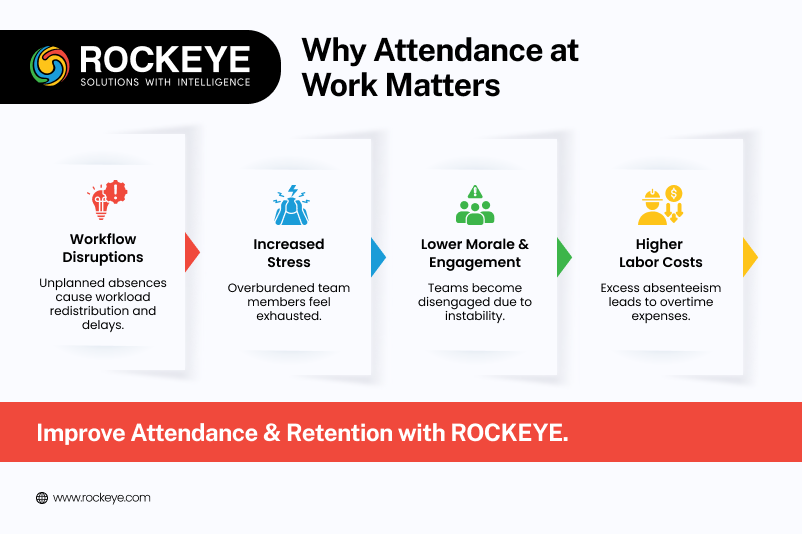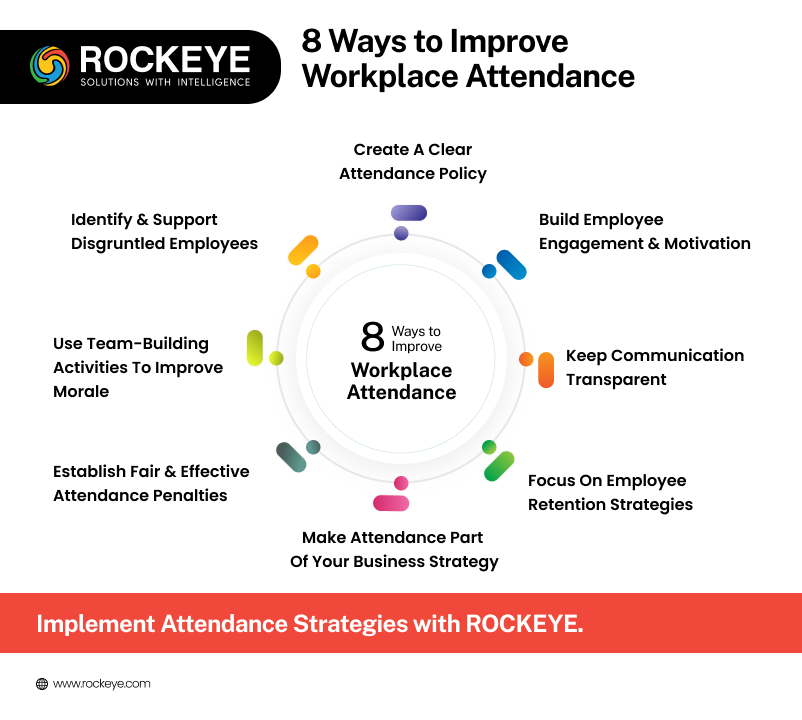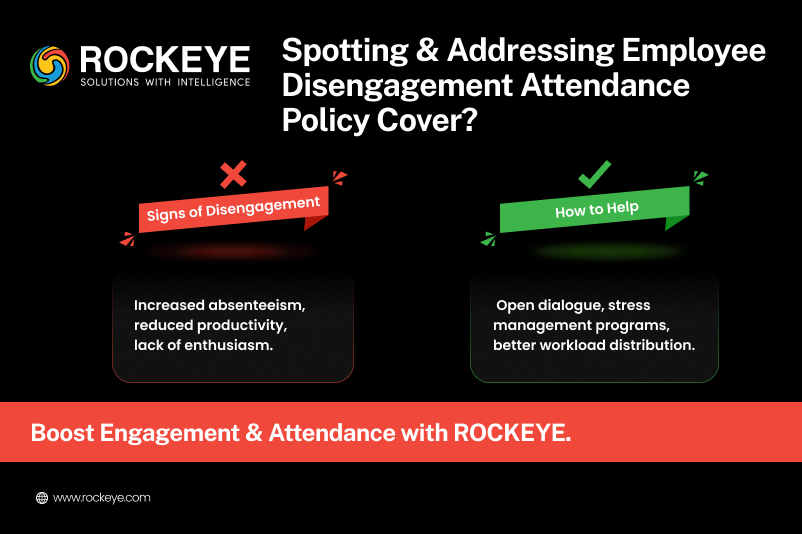Employee Attendance Management may not seem like a crucial issue when you’re dealing with larger concerns like keeping the lights on and the doors open. But, if an employee is regularly missing from your roster, it can affect the rest of your team — and even the ultimate success of your business.
In this blog , we’ll discuss some of the reasons why Employee Attendance Management matters and give you tips for improving attendance throughout your company.
Why Employee Attendance Management Matters

Ultimately, Employee Attendance Management matters because of the role it plays in a variety of issues, including:
- Workflow
- On-the-job stress
- Team morale
- Employee engagement
- Labor costs
Where workflow is concerned, if an employee is regularly absent, managers may have to redistribute the assignments in order to ensure everything gets done properly and on time. That can lead to delays and confusion among other team members working on the project.
In addition, the constant uncertainty and shuffling of the workload causes more stress for those team members who are shouldering the brunt of the extra work that the absent employee would have handled.
And, when one employee fails to show up day after day, their poor Employee Attendance Management can cause a drop in both team morale and employee engagement.
Too much of all that and team members may even start to leave your business in search of a less stressful, more engaging work environment (inflating your labor costs in the process).
Once it gets started, this cycle of reshuffling the workload, increased stress, and decreased morale and engagement creates a downward spiral that can be incredibly difficult to rectify.
But you can avoid the negative effects of delinquent employees by implementing the tips in the next section to improve Employee Attendance Management.
How To Improve Employee Attendance Management

1) Create An Attendance Policy
One of the first steps in improving Employee Attendance Management is to create a policy that handles the issues associated with showing up on time every day, including:
- Tardiness
- Early clock-outs
- Excused absences
- Unexcused absences
- Overtime
- No-call, no-shows
- Job abandonment
If your business has access to a cloud-based team management app that allows file sharing, you can make your attendance policy digital so that all your employees can access the document whenever they need it and wherever they are.
If a digital option isn’t viable for your business, make a hard copy of the attendance policy and distribute it to everyone on your team.
2) Build Employee Engagement
Employee engagement is the ability of your team members to be present in the moment, focused on the task at hand, and motivated to do the best work possible.
And, as we mentioned earlier, it’s one of the first things to suffer when an employee’s attendance takes a turn for the worse.
You can counteract this negative tendency by taking steps to build employee engagement whenever possible.
If you’re unsure how to do this, try implementing one or more of these suggestions to get things going:
- Implement a frustration box
- Brainstorm with your team about engagement
- Create a clear hierarchy of responsibility
- Encourage innovation
- Improve your leadership skills
- Allow for work/life balance

3) Keep The Lines Of Communication Open
Maintaining high attendance in your business requires you and your team working hard to keep the lines of communication open at all times.
Effective communication is defined as the act of exchanging information, ideas, and feelings between individuals and groups through written or verbal means in such a way that everyone understands and knows what to do next.
Communication at work matters because it prevents confusion, gives everyone a voice, and keeps your entire team up to date on what’s going on in the business.
4) Focus On Employee Retention
When you examine the subject of attendance, you soon discover that employee retention lies at the center of it all. Armed with that knowledge, you can focus on the basics of keeping employees on the job longer as a way to deal with the attendance issue.
Strengthening the foundation of attendance by dealing with the underlying issue — employee retention — goes a long way toward improving both the short- and long-term condition of your team and your business.
5) Make Employee Attendance Management Part Of Your Strategy
Whether attendance is a problem or not, one of the best ways to get control of the issue is to make it a part of your business strategy.
Employee Attendance Management applies to your team members directly, so incorporating it into your functional-level strategy — where the rubber meets the road, so to speak — is the best option.
Occasionally, you can deal with attendance in your business-level strategy but refrain from trying to find a place for it in your corporate-level strategy. This high level is best reserved for large business goals, like expanding your product offering or setting up a new location.
6) Identify Disgruntled Employees
Often, one of the first indicators of a disgruntled employee is a lower rate of attendance. They’re not enjoying their job — or are completely burnt out — and will look for any excuse to stay home.
While that may not be a bad thing in some cases, their attitude can infect the rest of your employees and spot an otherwise high-functioning team.
If you suspect you may have a disgruntled employee in your midst, do your best to help them reverse course. Keep the atmosphere at work positive, provide counseling, and express your trust in them.
7) Play Team-Building Games
Playing team-building games is a great way to address a number of issues your employees may face while on the job — Employee Attendance Management included.
These games don’t have to be long and drawn out to be effective — just 10 or 15 minutes once or twice a week — but they do need to be fun and engaging for those who participate.
Here are some of our favorite ideas for in-person, remote, and hybrid teams alike:
- Typing race
- Puzzle race
- Emoji name that tune
- Then and now
If you’re unsure what your team might enjoy, you can always run a fun Q & A session with questions like:
- What is something you think is overrated?
- Dogs or cats?
- Would you rather join Metallica or the New Kids On The Block?
- What is the worst gift you’ve ever received?
- Do you fold your pizza?
- Thick pizza or thin?
- If you could be any animal for a week, which would you choose?
The point of all this is to get your employees to relax, have fun, and bond with their coworkers.
8) Establish Penalties

If you haven’t already established penalties for low Employee Attendance Management, do so right away and include them in the policy mentioned at the beginning of this list.
While you don’t want to always lead with the negative, potential penalties are the best — and, sometimes, the only — deterrent that will keep your employees from being absent on a regular basis.
Some businesses choose to go the zero-tolerance route and set up severe penalties (even immediate termination) for the first offense. Other businesses even allow absences if the employee makes up the time within a week of their return.
You might even try implementing a system where different types of absences accrue points that are applied to a total. If the employee reaches a certain total, your business levies various penalties, including:
- Verbal warning
- Written warning
- Meeting with supervisor
- Suspension without pay
- Termination
Choose the penalty policy that works best for you, your team, and your business.
Boost Employee Attendance Management With ROCKEYE
The right tools — like ROCKEYE HRMS — can help you boost Employee Attendance Management like never before.
We built ROCKEYE to simplify and streamline every aspect of your scheduling, task administration, time tracking, attendance management, and team organization.
Those features — along with cloud-based operation and broad device- and operating-system availability — make improving Employee Attendance Management easier than ever before.
ROCKEYE ESS even gives your team members the flexibility to clock in and out right from their smartphone. The app then goes on to notify you when an employee is tardy, forgets to clock in, or is altogether absent from work.
That’s powerful attendance management in the palm of your hand.
For more free resources to help you run your business better, organize and schedule your team, improve Employee Attendance Management, and track and calculate labor costs, connect with us today.
FAQs:
Q1: Why does Employee Attendance Management matter?
Employee Attendance Management matters because it affects workflow, team morale, employee engagement, on-the-job stress, and labor costs. Regular absences lead to project delays, increased stress on teammates, and decreased morale — all of which can spiral into bigger issues like employee turnover.
Q2: What’s the first step to improving attendance?
Create an attendance policy. It should address things like tardiness, early clock-outs, excused and unexcused absences, no-call no-shows, overtime, and job abandonment. Make it accessible to everyone—digitally or through hard copies.
Q3: How does employee engagement tie into attendance?
When attendance drops, engagement is usually the first thing to suffer. Employees feel disengaged, stressed, and less motivated. You can build engagement by encouraging innovation, leadership growth, clear responsibility, and work/life balance.
Q4: What role does communication play in managing attendance?
Open communication prevents confusion, gives everyone a voice, and ensures the team is on the same page. Keeping communication active is key to maintaining high attendance.
Q5: How is employee retention connected to attendance?
Retention is at the heart of attendance. If you focus on keeping your employees longer, you’ll naturally improve attendance and reduce the underlying issues causing absences.

